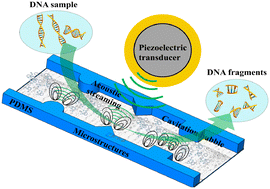Polydimethylsiloxane microstructure-induced acoustic streaming for enhanced ultrasonic DNA fragmentation on a microfluidic chip†
Abstract
Next-generation sequencing (NGS) is an essential technology for DNA identification in genomic research. DNA fragmentation is a critical step for NGS and doing this on-chip is of great interest for future integrated genomic solutions. Here we demonstrate fast acoustofluidic DNA fragmentation via ultrasound-actuated elastic polydimethylsiloxane (PDMS) microstructures that induce acoustic streaming and associated shear forces when placed in the field of an ultrasonic transducer. Indeed, acoustic streaming locally generates high tensile stresses that can mechanically stretch and break DNA molecule chains. The improvement in efficiency of the on-chip DNA fragmentation is due to the synergistic effect of these tensile stresses and ultrasonic cavitation phenomena. We tested these microstructure-induced effects in a DNA-containing microfluidic channel both experimentally and by simulation. The DNA fragmentation process was evaluated by measuring the change in the DNA fragment size over time. The chip works well with both long and short DNA chains; in particular, purified lambda (λ) DNA was cut from 48.5 kbp to 3 kbp in one minute with selected microstructures and further down to 300 bp within two and a half minutes. The fragment size of mouse genomic DNA was reduced from 1.4 kbp to 400 bp in one minute and then to 200 bp in two and a half minutes. The DNA fragmentation efficiency of the chip equipped with the PDMS microstructures was twice that of the chip without the microstructures. Exhaustive comparison shows that the on-chip fragmentation performance reaches the level of high-end professional standards. Recently, DNA fragmentation was shown to be enhanced using vibrating air microbubbles when the chip was placed in an acoustic field. We think the microbubble-free microstructure-based device we present is easier to operate and more reliable, as it avoids microbubble preparation and maintenance, while showing high DNA fragmentation performance.



 Please wait while we load your content...
Please wait while we load your content...